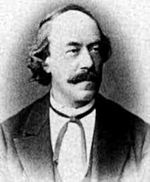Rudolf Lipschitz facts for kids
Quick facts for kids
Rudolf Lipschitz
|
|
|---|---|

Rudolf Lipschitz
|
|
| Born | 14 May 1832 |
| Died | 7 October 1903 (aged 71) |
| Nationality | German |
| Alma mater | University of Königsberg |
| Known for | Lipschitz continuity Lipschitz integral condition Lipschitz quaternion |
| Scientific career | |
| Fields | Mathematics |
| Institutions | University of Bonn |
| Doctoral advisor | Gustav Dirichlet Martin Ohm |
| Doctoral students | Felix Klein |
Rudolf Otto Sigismund Lipschitz (born May 14, 1832 – died October 7, 1903) was an important German mathematician. He made many discoveries in different areas of mathematics. These included mathematical analysis, where a special rule called the Lipschitz continuity condition is named after him. He also worked on differential geometry, number theory, and classical mechanics.
Contents
Rudolf Lipschitz's Life Story
Rudolf Lipschitz was born on May 14, 1832, in a city called Königsberg. His father was a landowner, and Rudolf grew up on his family's estate.
When he was just 15 years old, Rudolf started studying at the University of Königsberg. Later, he moved to the University of Berlin. There, he studied with a famous mathematician named Gustav Dirichlet. Even though he got sick and his studies were delayed, Lipschitz earned his PhD in Berlin in 1853.
Early Career and Family Life
After getting his PhD, Lipschitz began teaching at local schools called Gymnasiums. In 1857, he married Ida Pascha. Her family also owned land near his father's estate.
In the same year, 1857, he earned his habilitation at the University of Bonn. This allowed him to teach at a university. He stayed at Bonn as a privatdozent, which means he was a private lecturer.
In 1862, Lipschitz became an extraordinary professor at the University of Breslau. He taught there for two years. Then, in 1864, he returned to Bonn as a full professor. He was the first Jewish full professor at Bonn University. In 1869, he was given the first special position for mathematics at Bonn. He stayed there for the rest of his career. One of his students there was Felix Klein, who also became a very famous mathematician. Rudolf Lipschitz passed away in Bonn on October 7, 1903.
Discovering Clifford Algebras
Rudolf Lipschitz made an important discovery in 1880. He found something called Clifford algebras. This was just two years after another mathematician, William K. Clifford, had found them independently. Lipschitz was the first to use these algebras to study orthogonal transformations. These are special ways to move shapes without changing their size or form.
For a long time, people called these discoveries "Clifford–Lipschitz numbers." However, over time, Lipschitz's name was often left out of discussions about Clifford algebras. For example, a mathematician named Claude Chevalley named something the "Clifford group." But this group was actually based on Lipschitz's work, not Clifford's.
Later, a mathematician named Pertti Lounesto helped remind everyone how important Lipschitz's role was in this discovery.
Important Books by Rudolf Lipschitz
Rudolf Lipschitz wrote several important books and papers during his career. Here are a few of them:
- Lehrbuch der Analysis (This means "Textbook of Analysis") – It came out in two parts in 1877 and 1880.
- Wissenschaft und Staat (Meaning "Science and State") – Published in 1874.
- Untersuchungen über die Summen von Quadraten (Meaning "Investigations on the Sums of Squares") – Published in 1886.
- Bedeutung der theoretischen Mechanik (Meaning "Importance of Theoretical Mechanics") – Published in 1876.
See Also
 In Spanish: Rudolf Lipschitz para niños
In Spanish: Rudolf Lipschitz para niños
- Cauchy–Lipschitz theorem
- Lipschitz continuity
- Lipschitz quaternion

